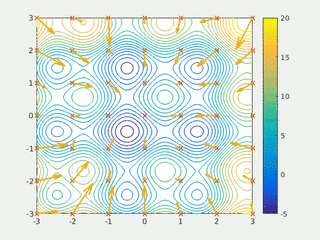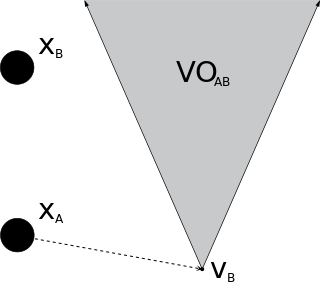
In mathematics, computer science and operations research, mathematical optimization or mathematical programming is the selection of a best element from some set of available alternatives.
Muzzle velocity is the speed of a projectile at the moment it leaves the end of a firearm. Muzzle velocities range from approximately 120 m/s (390 ft/s) to 370 m/s (1,200 ft/s) in black powder muskets, to more than 1,200 m/s (3,900 ft/s) in modern rifles with high-performance cartridges such as the .220 Swift and .204 Ruger, all the way to 1,700 m/s (5,600 ft/s) for tank guns firing kinetic energy penetrator ammunition. To simulate orbital debris impacts on spacecraft, NASA launches projectiles through light-gas guns at speeds up to 8,500 m/s (28,000 ft/s).

In computational science, particle swarm optimization (PSO) is a computational method that optimizes a problem by iteratively trying to improve a candidate solution with regard to a given measure of quality. It solves a problem by having a population of candidate solutions, here dubbed particles, and moving these particles around in the search-space according to simple mathematical formulae over the particle's position and velocity. Each particle's movement is influenced by its local best known position, but is also guided toward the best known positions in the search-space, which are updated as better positions are found by other particles. This is expected to move the swarm toward the best solutions.

A two-stage-to-orbit (TSTO) or two-stage rocket launch vehicle is a spacecraft in which two distinct stages provide propulsion consecutively in order to achieve orbital velocity. It is intermediate between a three-stage-to-orbit launcher and a hypothetical single-stage-to-orbit (SSTO) launcher.

A water supply system or water supply network is a system of engineered hydrologic and hydraulic components which provide water supply. A water supply system typically includes:
- A drainage basin.
- A raw water collection point where the water accumulates, such as a lake, a river, or groundwater from an underground aquifer. Raw water may be transferred using uncovered ground-level aqueducts, covered tunnels or underground water pipes to water purification facilities.
- Water purification facilities. Treated water is transferred using water pipes.
- Water storage facilities such as reservoirs, water tanks, or water towers. Smaller water systems may store the water in cisterns or pressure vessels. Tall buildings may also need to store water locally in pressure vessels in order for the water to reach the upper floors.
- Additional water pressurizing components such as pumping stations may need to be situated at the outlet of underground or above ground reservoirs or cisterns.
- A pipe network for distribution of water to the consumers and other usage points.
- Connections to the sewers are generally found downstream of the water consumers, but the sewer system is considered to be a separate system, rather than part of the water supply system.
Shape optimization is part of the field of optimal control theory. The typical problem is to find the shape which is optimal in that it minimizes a certain cost functional while satisfying given constraints. In many cases, the functional being solved depends on the solution of a given partial differential equation defined on the variable domain.
In aerosol physics, deposition is the process by which aerosol particles collect or deposit themselves on solid surfaces, decreasing the concentration of the particles in the air. It can be divided into two sub-processes: dry and wet deposition. The rate of deposition, or the deposition velocity, is slowest for particles of an intermediate size. Mechanisms for deposition are most effective for either very small or very large particles. Very large particles will settle out quickly through sedimentation (settling) or impaction processes, while Brownian diffusion has the greatest influence on small particles. This is because very small particles coagulate in few hours until they achieve a diameter of 0.3 micrometres. At this size they no longer coagulate. This has a great influence in the amount of PM-2.5 present in the air.
Pursuit-evasion is a family of problems in mathematics and computer science in which one group attempts to track down members of another group in an environment. Early work on problems of this type modeled the environment geometrically. In 1976, Torrence Parsons introduced a formulation whereby movement is constrained by a graph. The geometric formulation is sometimes called continuous pursuit-evasion, and the graph formulation discrete pursuit-evasion. Current research is typically limited to one of these two formulations.

The Knight's Armament Company 6×35mm PDW is an experimental personal defense weapon designed by Knight's Armament Company (KAC), firing a new 6mm cartridge optimized for short barrel weapons. A variant chambered in .300 AAC Blackout also available.
The boustrophedon cell decomposition (BCD) is a method used in artificial intelligence and robotics for configuration space solutions. Like other cellular decomposition methods, this method transforms the configuration space into cell regions that can be used for path planning.
A blazed grating – also called echelette grating – is a special type of diffraction grating. It is optimized to achieve maximum grating efficiency in a given diffraction order. For this purpose, maximum optical power is concentrated in the desired diffraction order while the residual power in the other orders is minimized. Since this condition can only exactly be achieved for one wavelength, it is specified for which blaze wavelength the grating is optimized. The direction in which maximum efficiency is achieved is called the blaze angle and is the third crucial characteristic of a blazed grating directly depending on blaze wavelength and diffraction order.
In robotics motion planning, the dynamic window approach is an online collision avoidance strategy for mobile robots developed by Dieter Fox, Wolfram Burgard, and Sebastian Thrun in 1997. Unlike other avoidance methods, the dynamic window approach is derived directly from the dynamics of the robot, and is especially designed to deal with the constraints imposed by limited velocities and accelerations of the robot.
Shear Velocity, also called friction velocity, is a form by which a shear stress may be re-written in units of velocity. It is useful as a method in fluid mechanics to compare true velocities, such as the velocity of a flow in a stream, to a velocity that relates shear between layers of flow.
In robotics and motion planning, kinodynamic planning is a class of problems for which velocity, acceleration, and force/torque bounds must be satisfied, together with kinematic constraints such as avoiding obstacles. The term was coined by Bruce Donald, Pat Xavier, John Canny, and John Reif. Donald et al. developed the first polynomial-time approximation schemes (PTAS) for the problem. By providing a provably polynomial-time ε-approximation algorithm, they resolved a long-standing open problem in optimal control. Their first paper considered time-optimal control of a point mass under Newtonian dynamics, amidst polygonal (2D) or polyhedral (3D) obstacles, subject to state bounds on position, velocity, and acceleration. Later they extended the technique to many other cases, for example, to 3D open-chain kinematic robots under full Lagrangian dynamics. More recently, many practical heuristic algorithms based on stochastic optimization and iterative sampling were developed, by a wide range of authors, to address the kinodynamic planning problem. These techniques for kinodynamic planning have been shown to work well in practice. However, none of these heuristic techniques can guarantee the optimality of the computed solution, and none can be mathematically proven to be faster than the original PTAS algorithms.
In C++ computer programming, copy elision refers to a compiler optimization technique that eliminates unnecessary copying of objects. The C++ language standard generally allows implementations to perform any optimization, provided the resulting program's observable behavior is the same as if, i.e. pretending, the program were executed exactly as mandated by the standard.
Tower 6789, also known as Makati Tower, is a commercial skyscraper in Makati, Metro Manila, Philippines. With a height of 180 meters and 35 floors, Tower 6789 is also the 11th tallest building in the country's financial district, closely following RCBC Plaza Yuchengco Tower. It has a gross floor area of 48,000 square meters with a floor template between 1,100 and 1600 sqms. The tower was owned by local developer Alphaland, a joint venture between London-based private equity fund Ashmore Group and RVO Capital Ventures of former Trade Minister Roberto V. Ongpin, but was already transferred to give Ashmore 100 percent ownership.







